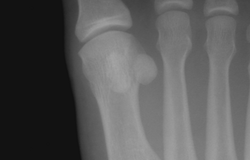Sesamoid
| Sesamoid bone | |
|---|---|

Sesamoid bones at the distal end of the first metatarsal bone of the foot.
|
|
| Details | |
| Identifiers | |
| Latin | ossa sesamoidea |
| TA | A02.0.00.016 |
| FMA | 32672 |
|
Anatomical terms of bone
[]
|
|
In anatomy, a sesamoid bone (/ˈsɛsəmɔɪd/) is a bone embedded within a tendon or a muscle. It is derived from the Latin word "sesamum" (sesame seed), due to the small size of most sesamoids. Often, these bones form in response to strain. Sesamoids act like pulleys, providing a smooth surface for tendons to slide over, increasing the tendon's ability to transmit muscular forces.
Sesamoid bones can be found on joints throughout the body, including:
In equine anatomy, the term sesamoid bone usually refers to the two sesamoid bones found at the back of the fetlock or metacarpophalangeal/metatarsophalangeal joints in both hindlimbs and forelimbs. Strictly these should be termed the proximal sesamoid bones whereas the navicular bone should be referred to as the distal sesamoid bone. The patella is also a form of sesamoid bone in the horse.
In both the giant panda and the red panda, the radial sesamoid is larger than the same bone in counterparts such as bears. It is primarily a bony support for the pad above it, allowing the panda's other digits to grasp bamboo while eating it. The panda's thumb is often cited as a classical example of exaptation, where a trait evolved for one purpose is commandeered for another.
...
Wikipedia
